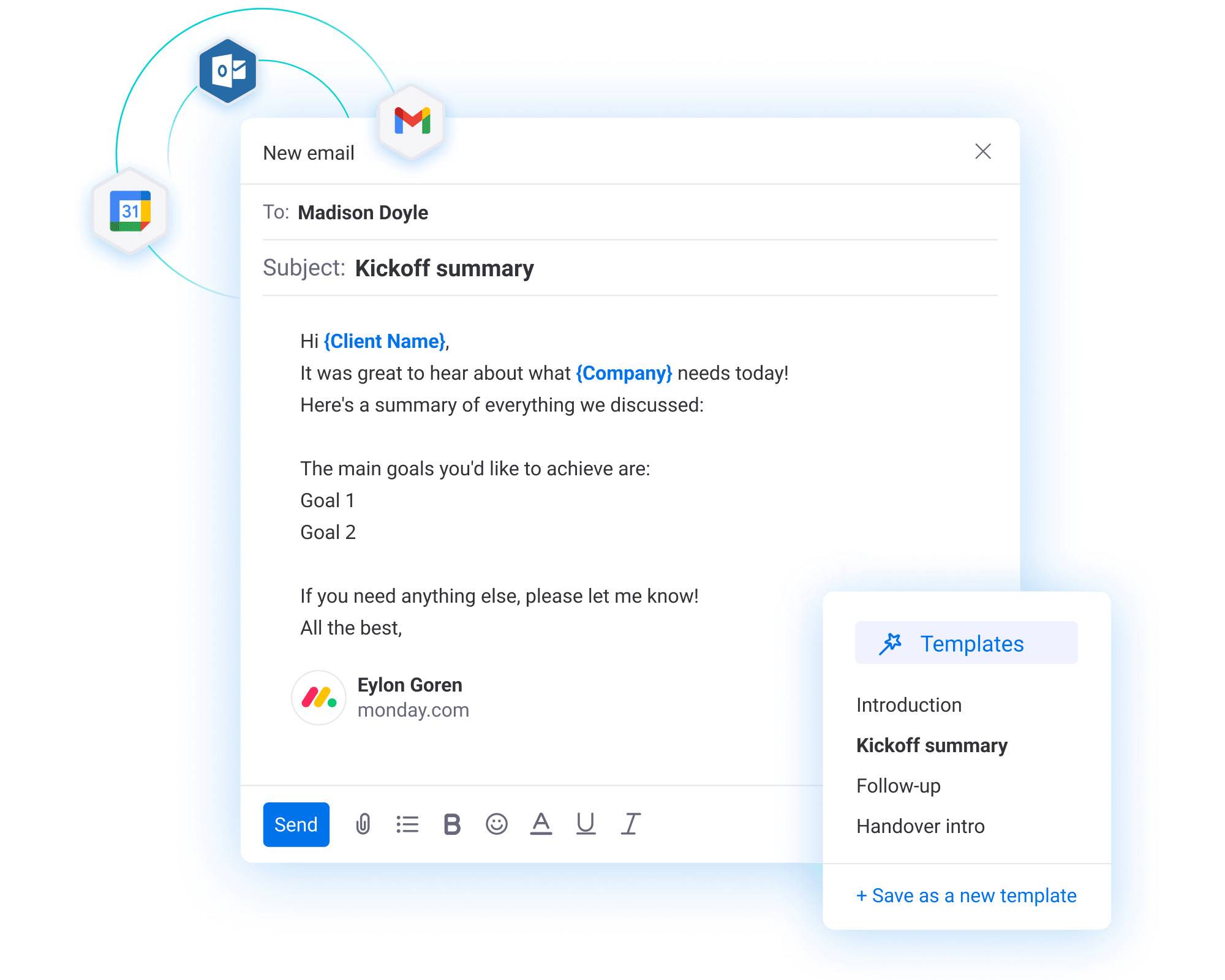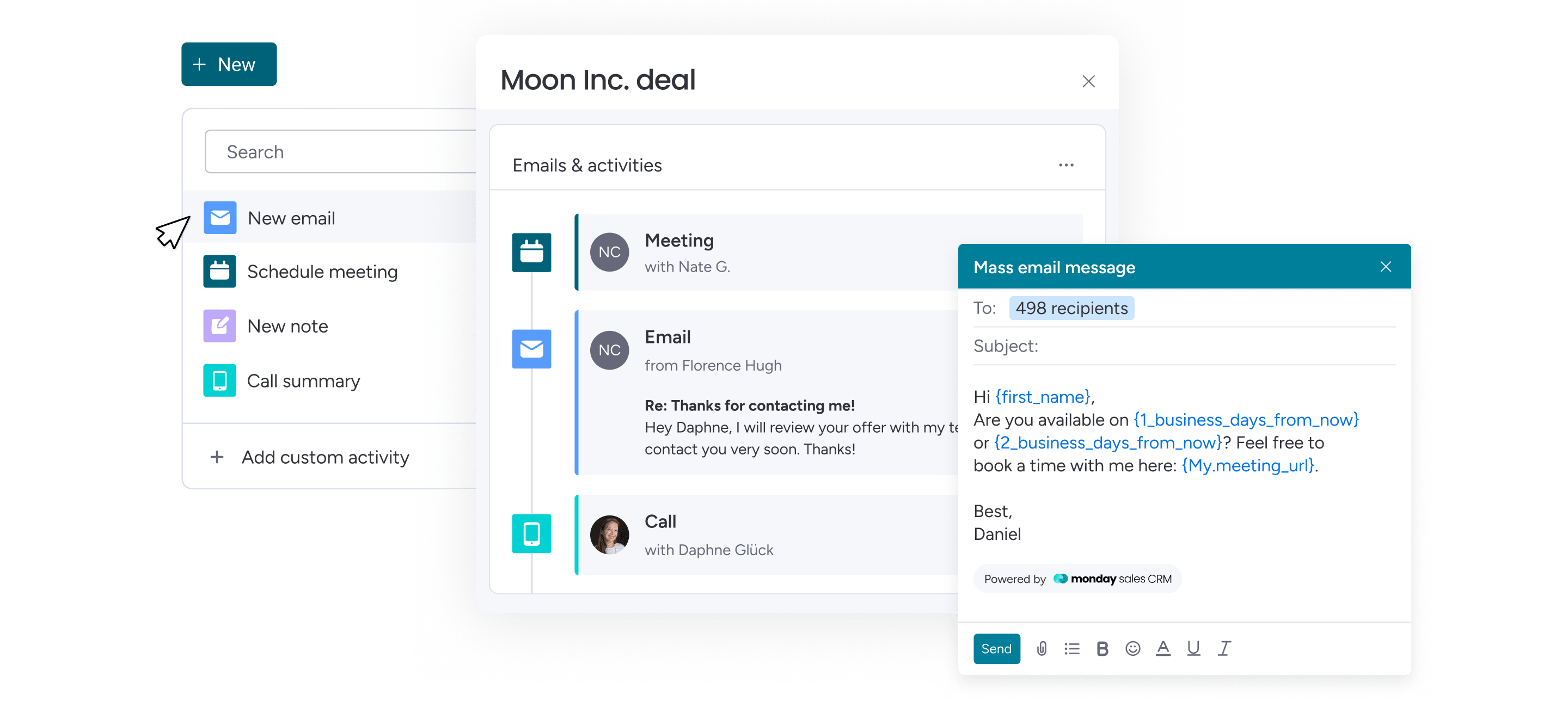I’ve just finished eating a spectacular chocolate chip cookie. Again. And I blame personalization entirely. You see, the barista at my local coffee shop knows my name. She knows my dog’s name. And, worst of all, she knows my weakness for chocolate chip cookies. I go in planning to order a coffee–and I leave clutching a freshly baked slice of chocolate-chip heaven. And that right there is the power of personalization.
Of course, if you’re selling to people online, then you have to find ways to build that level of connection and understanding digitally. Email personalization is one of the most potent ways to form a relationship with customers you’ll never meet in real life.
In this article, we’ll talk about the crux of email personalization to discover why it’s so effective. We’ll also give you a complete guide of the do’s and don’ts of personalized emails, according to industry experts and introduce monday sales CRM software to create personalized emails, share templates with your team, track email open rates, and much more.
What is email personalization?
Email personalization is the technique of using data to create a unique email for every person on your list.

Here are a few examples of how you can use email personalization in your business:
- Create personalized subject lines
- Ex: “Want to know how we could help [Your Business] generate more revenue today?
- Personalize the imagery you include in your emails, depending on what you know about the lead or customer
- Ex: Using female images for female-identifying customers)
- Address people by name
- Ex:. “Hi [Mary], and how are you today?”
- Send emails based on user behavior
- Ex: “We saw you checking out our website ;)” More on customer behavior analysis here.
- Send an email to a lead who abandoned their cart before hitting Buy
- Ex: “We noticed you left before making a purchase. Can we help you with something?”
- Provide customized notifications
- Ex: “[Client] sent you a payment – it’s arriving by [date].”
- Give personalized product recommendations
- Ex: “We thought you might be interested in our new [Product].
- Segment your leads or customers into groups based on their location, age range, or interests and send them specific, targeted emails
- Ex: “We’ve just opened a new store in your neighborhood.” More on email segmentation in this post.
- Modify email templates to add a human touch and show that you were paying attention to your prospect’s specific needs and wants during a sales call.
This approach to email lets you build a one-to-one relationship with your leads and customers, at scale.
Why email personalization works
Personalized emails outperform generic templates across every marketing metric. According to a 2021 report by McKinsey:
- Companies that use personalization in their marketing campaigns are making 40% more revenue than the competition;
- More than three-quarters of consumers are frustrated when brands don’t personalize their communications and services;
- Over 75% of consumers are more likely to recommend, purchase and repurchase from businesses that use personalization.
But what makes email personalization so effective?
1. Email personalization grabs our attention
As Dale Carnegie famously said, “A person’s name is, to that person, the sweetest, most important sound in any language.” Even if your inbox is overflowing, nothing is more likely to snag your attention than someone using your name.
In fact, research shows that hearing our own name causes us to switch our attention. It also triggers the release of dopamine, also known as the “happy hormone.”
Small wonder then that emails with a personalized subject line that uses the person’s name have a 26% higher open rate than those without.
2. Personalized emails build trust
Pauline Rouxeville, the Growth and Marketing Lead at Napta, a resource management software company, explains:
“Email personalization allows you to show the prospect that you know them and know who they are; that they aren’t just another email address among thousands. Therefore, you can increase trust between you two, create a natural closeness, and improve the quality of future exchanges.”
By creating unique, personalized content for each email recipient, you show them that you see them as a human being and have an interest in meeting their individual needs. This is critical for today’s more demanding consumers and building customer loyalty. For instance, research by Salesforce shows that two-thirds of customers expect companies to understand their unique needs and expectations.
3. Email personalization creates a lasting relationship
Generic emails are like a monologue. When brands use standardized email templates, they’re essentially standing on a soapbox, shouting about their products.
A personalized email, by contrast, opens up a conversation. It’s not a marketing leaflet from a brand–it’s a message from one human being to another. As a result, it’s far more effective at creating a lasting relationship with your customers: a published in AdAge found that 60% of consumers are likely to become repeat buyers after a personalized experience.
Five expert tips to help you master email personalization
Of course, we’ve all been the recipients of poorly implemented personalized email campaigns. You know the kind of thing: the writer addresses you by your email address instead of your name, or uses your first and last name (“Hi John Smith!”). Instead of creating a connection, this can have the exact opposite effect.
5 expert tips on how to use personalization to create more effective email campaigns
1. Start with clean customer data
Simon Tokic, the Marketing Director of Mind Methods, a full-service marketing agency, points out that all personalization starts with accurate, relevant data on your leads and customers:
“The key is ensuring that when a lead is contacted, at the start of the process, that we fill in all key segmentation information including the type of business, their geo location, business size, department etc. If this first step is missed, then you have very little information to develop any personalisation and have to resort to generic emails.”
2. Don’t overdo it
James Nesbitt, Founder of Myth Digital, a digital product design and development company, warns marketers that too much personalization can be a real turn-off:
“Using the contact’s name too frequently can make the email seem fake. The customer will soon recoil and abandon reading the rest of the email, and, even worse, they may be disinclined to open the next one they receive.”
The trick, says Nesbitt, is to get the balance right by “showing [your customers] that you know who they are, that you care about what they need and where they need it, but that you’re not trying to be their best friend!”
3. Dot your I’s and cross your T’s
Lee Moskowitz, the Director of Growth Marketing at SetSail, a RevOps software business, believes that the secret to effective email personalization is to check the details before you hit send:
“Make sure that your first name field contains only the person’s first name and not their full name. Starting an email off by greeting the person with “Hi [first name] [last name]” is not a good way to come across as human!
Additionally, if you are going to leverage [company name] to personalize your email, make sure you remove the business entities, such as Inc. and LLC, from their name. This helps avoid the robotic and foolish look of saying ‘How are things at Google LLC?’”
4. Be mindful of data privacy
Vaibhav Kakkar, the CEO of Digital Web Solutions, a global digital marketing agency, cautions marketers to handle lead and customer data with care. “Make sure that you are collecting and using recipient data by privacy laws and regulations,” he told us.
“Neglecting to secure or manage recipient data responsibly can lead to privacy violations and damage the brand’s reputation.” You’ll also break any trust you’ve managed to build up with your personalized emails.
5. Test, test, test
As with all digital marketing techniques, getting email personalization right will take iterations and testing, points out Rouxeville.
“Email personalization allows you to run A/B tests on a lot of data. For example, you can send emails where the personalization is based on the job title, a career move, an anniversary (“You’ve been working at TheBestCompany for a year now–congratulations!”) and see what kind of approach works best for your specific market.”
Effortlessly create personalized emails with monday sales CRM
Email personalization can feel complex when you’re first getting started. Learning how to build customized email sequences can take some trial and error. But monday sales CRM exists to make it all much easier:
- Email tracking automation: Save time and make sure to maximize your ROI with every email you send. With our automations, you can message your sales team when a lead opens an email, or get notifications about the best time to send out a marketing email to a specific customer.
- Email templates: Instead of adding personalized touches manually, you can create email templates that autofill personalized details based on your contacts’ information.
- Email integration: Seamlessly integrate our CRM with Gmail and Outlook, so you can send, receive, and track emails without having to click through multiple tabs. monday sales CRM also integrates with your favorite email marketing tools, such as Mailchimp, so you can consolidate all your email tracking metrics in one reliable place.
- Dashboard reporting: Visualize your email campaign metrics through customized dashboards and reporting widgets on your board so you can best understand what your metrics mean, and ensure your whole team has easy access to them as well. Try monday sales CRM for free today and see how easy it can be to create and send compelling, high-converting personalized emails.

Looking to learn more about email personalization? We’ve included some frequently asked questions below.
FAQs
What is email personalization?
Email personalization is a digital marketing technique that makes your emails more effective. In a personalized email, you customize the details of the email to make it unique for each recipient. For example, you could address the recipient by name, show them relevant content or product recommendations, or send them a specific email in response to a particular behavior.
How do you personalize an email?
There are a lot of different ways you can personalize your emails. Examples include adding someone’s first name to the subject line, sending different email templates to different market segments, or sending an email in response to a specific user behavior (such as abandoning their online cart before purchasing).
How do you personalize an email with a name?
The easiest way to add the recipient’s name to an email is to create a template with dynamic fields–blank fields that are different for each recipient. For instance, your email template could begin, “Hi [First name].” If you use monday sales CRM, it will then automatically fill in that field by extracting the information from the relevant column in your database of leads or customers. The result is a personal email that people will be more likely to open and read.
Get email personalization right with monday sales CRM
Email personalization can be a powerful tool for customer engagement and converting your leads and prospects. But getting it right requires a robust CRM that will let you and your team create, test, and improve your emails every time. Monday’s sales CRM with email marketing makes it easy to centralize your sales communications, collaborate on email templates, and track your email performance all in one place. Try it out, and see what email personalization can do for your business.

